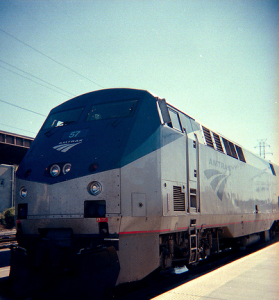High Speed Rail Can Help Push Economic Development In Texas
 High speed rail can change how we experience our local communities, state and the rest of our nation.
High speed rail can change how we experience our local communities, state and the rest of our nation.
I grew up in El Paso, a city that relies on cars to get around — despite the fact that it once had the most advanced binational mass transportation system on an international boundary in the world, up until the 1970s. My first encounter with a train, aside from the monorail at Disneyland, was in 1984 when my family rode the Sunset Limited from west Texas to eastern Louisiana so that we could visit the World’s Fair firsthand in New Orleans.
A little over a decade later I was relying on a train a town over from Wesleyan University that would connect central Connecticut with Times Square. A few times each semester I would transfer at Grand Central Station and head to Poughkeepsie to visit my sister, looking forward to the Hudson River, and the fun waiting to begin once I reached my stop just outside of Vassar College. Nowadays I catch the train from Long Island to visit my friends in the city as well as Connecticut, and the rest of the region.
Throughout New York, Boston, Washington D.C. and Chicago, I have relied on integrated train systems to provide me with a comfortable and unique travel experience that allows me to be creative while I am in motion. I am 6’2” and I just don’t fit on planes comfortably, and it is so much easier to read, use my computer and rest peacefully on a train than in flight. Recently, I found myself westbound on the Sunset Limited heading from San Antonio to Del Rio, Alpine and then to El Paso.
A train trip across Texas is much superior to flying — if only high speed rail could connect central Texas to the rest of the borderlands and radically reduce the duration of terrestrial travel. The technology utilized across Europe for high speed rail, if applied in Texas, would reduce train rides from San Antonio to El Paso to under four hours — this is less than half the time it takes to traverse this distance by car on Interstate 10.
The vastness of my state has historically impeded the flow of residents between the core of central Texas and the peripheral communities along the border, coastline and panhandle. Preemptive investment in the infrastructure for rail to facilitate affordable, high speed passenger transportation can help link a new generation of students, professionals, entreprenuers and innovators from throughout the state to the regions that are most capable of harnessing their ideas, talents and new enterprises. Promoting “super trains” and a new culture of regional collaboration through investment in high speed rail will benefit our state’s economy for the long-term and provide greater access to emerging fields of employment across the state.
But how much longer will we have to wait for more elected officials to advocate for high speed rail in Texas? Earlier this year, when Florida rejected more than $2 billion in funding, states like New York, New Jersey and California were more than eager to take the money to build, expand, or improve their rail lines.
When I finally made it to downtown El Paso on the train, it was clear that in order for our community to benefit from high speed rail, we need to invest in building out our current regional train system; we could potentially link El Paso/Ciudad Juárez/Las Cruces to central Texas and eventually northward, parallel to the Rio Grande, through northern New Mexico. Increased investment in state of the art mass transportation systems that link an array of fuel efficient public transportation technologies across the state will provide border communities with the ability to integrate high speed rail in the coming decades as the technology expands throughout the greater Southwest.
So, on a hot day in downtown El Paso, it turns out my hometown can again be recognized for being on the cutting edge of mass transportation by promoting high speed rail in Texas, New Mexico and Chihuahua.
Joseph P. A. Villescas, Ph.D. is an independent consultant, writer and instructor. He conducts extensive investigations on Latino and other multidimensional populations that explore trends in their educational development, media consumption, internet usage, voting behaviors, racial categorization, organizational capacities and readiness for future leadership roles in community settings. He is the founder and owner of Villescas Research, Media & Instruction, LLC.
[Photo By Mobilus In Mobili]
